Home
The complete list of Mexican tacos you must try before you die!
- Details
- Written by: Martin Pramatarov
- Hits: 3110
Tacos! They are one of the most delicious Mexican food that you can imagine. Mexican tacos come in all shapes and sizes. You can have them with chicken, port, beef, fish, or even exotic meats like alligator and boar. The tacos’ potential is unlimited! But which types of tacos are the most popular?
Here you have all the best Mexican tacos, which you must try when you visit Mexico!
| Follow PackAndGo.info at: | |
| YouTube | @packandgo. |
| @packandgo.info | |
| X | @packandgoinfo |
| Bluesky | @packandgo.bsky.social |
| @packandgo.info | |
| TikTok | @packandgo.info |
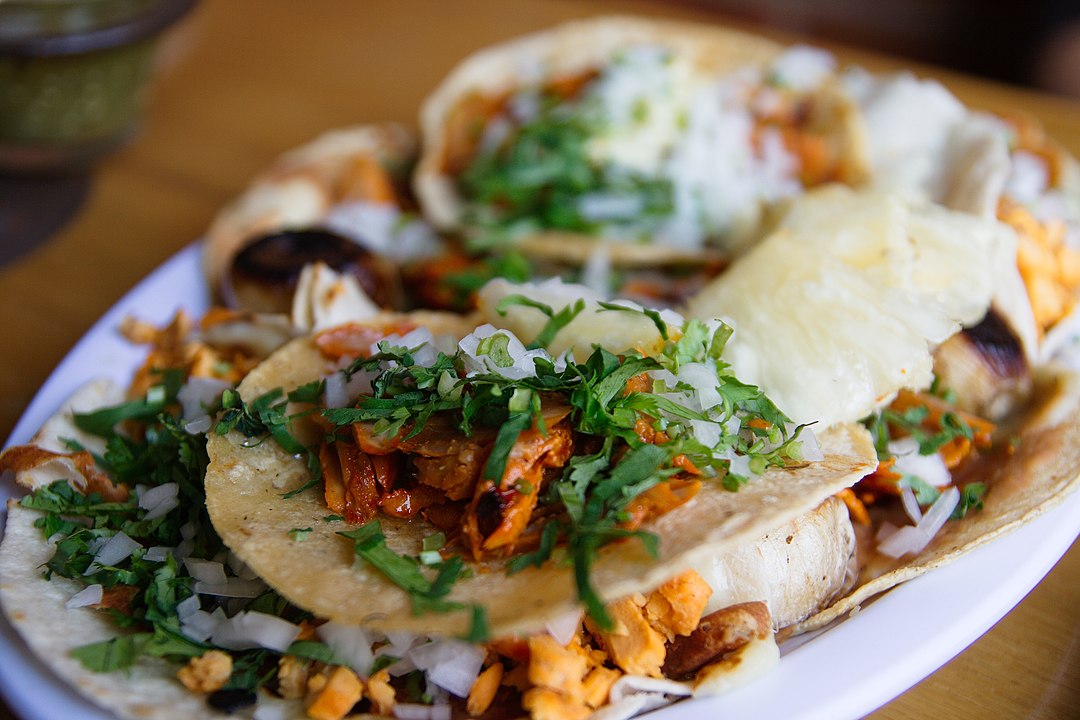
What is a Mexican taco?
The taco is a traditional Mexican food, that has two main ingredients – tortilla and filling.
The tortilla is a circular bread with a diameter between 5cm and 20cm and it is made of corn flour or wheat flour.
The filling could be very diverse. Usually, it is some kind of meat – pork, beef, chicken, and a salad garnish.
The extra ingredients that you can put on the tacos are:
-
Sauces – typically spicy sauces, but there are also more neutral ones.
-
Cream.
-
Salad.
-
Beans.
-
Nopales (cactus).
-
Rice.
-
Lemon.
-
Radish.
- Cheese.
Tacos al pastor – pork meat.
These are the most popular types of Mexican tacos in the whole Mexico. You can see taco stands in almost every street in Mexico City. From far, the tacos al pastor look like shawarma or döner kebab, because the chefs use the same kind of vertical grill. The truth is that the origin of this type of tacos is really the Middle East. Many immigrants from there, came to Mexico at the end of the 19th century and brought their food. The mixture with the Mexican culture and habits, change the lamb meat with the more popular in Mexico pork meat.
The meat that tacos al pastor have is spit-grilled pork. The typical marinate for the meat is chile guajillo or chile de árbol and other spices.
The garnish is onion, cilantro, lemon juice, pineapple, and great sauce (salsa verde) or red sauce (salsa roja). Everything comes inside delicious corn tortillas.

Tip: The taquero (the taco chef) will always ask you in the end “¿Con todo?” which means “with everything?". If you don’t like something, now is the moment to mention it.
Tacos Árabes – pork meat.
The tacos Árabes are almost the same as tacos al pastor. Again, they are pork meat, with onion, cilantro, and lemon. The main difference is the tortillas, which are wheat tortillas. The tacos Árabes are extremely popular in Puebla, a big city close to the capital.
Garnish – onions, cilantro, lemon, and cheese.
Tortilla – wheat.

Bistec tacos – beef meat.
The bistec tacos (tacos de bistec) are one of the easiest to cook, but they are amazing! They are very thin beef stakes, prepared on a grill. The usual garnishes are small onions and cilantro, and corn tortillas. Simple but great option. The big difference here is the sauces. You can have a great taste if you put chipotle sauce on it. And to top it off, you can add manchego cheese too.

Arrachera tacos – beef meat.
Arrachera is another type of steak that is known as the hanger cut. The arrachera meat is very thin, and that makes it very easy and fast to cook on the grill. The secret to its taste is the marinade. It includes different citrus like lime and orange, garlic, cilantro, hot chilies, oregano, cooking oil, and black paper.
Garnish – onions, red peppers, cilantro, lemon, nopales (cactus).
Tortilla – corn or wheat.
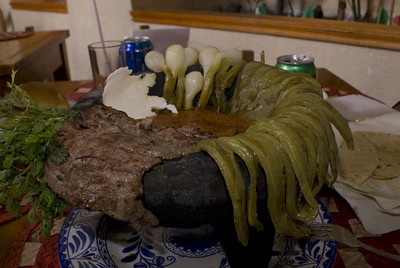
Carne asada tacos – beef meat.
When we talk about carne asada, it means that it is roasted. It is a marinated steak that gets its smoked flavor from charcoal. Otherwise, it is the same cow meat as the bistec tacos. You can find this kind of tacos more in the north. Monterrey is a great city to try tacos de carne asada.
Garnish – onion, cilantro, and hot sauce.
Tortilla – corn or wheat.
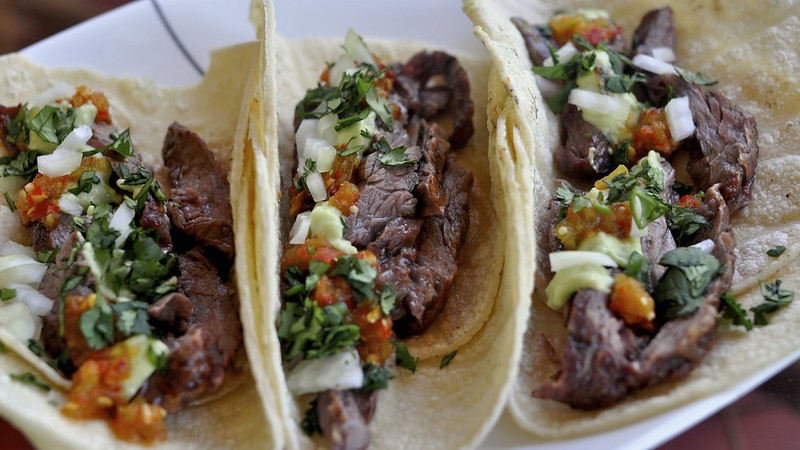
Cecina tacos – beef meat.
Tacos de cecina are very similar to those of bistec. Again, we are talking about beef meat, but this time it has a special process. The meat is dried and salted. These tacos are coming from the state of Morelos, near the capital Mexico City.
Garnish – nopales (cactus) and avocado.
Tortilla – corn.
Tip: Go to Yecapixtla (state of Morelos) to try tacos de cecina! I tried them there and fell in love with their taste.
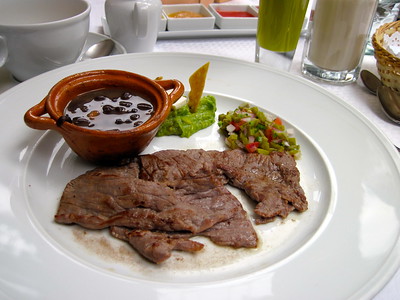
Tasajo taco – beef meat.
Tacos de tasajo are Spanish-style tacos from beef meat, very similar to cecina. It is dried beef meat, cooked on charcoal, and you can find them in most of the southern states like Oaxaca, Chiapas, Veracruz, and Campeche.
Garnish – onions, cilantro, lemon, beans and sauce.
Tortilla – corn or wheat.
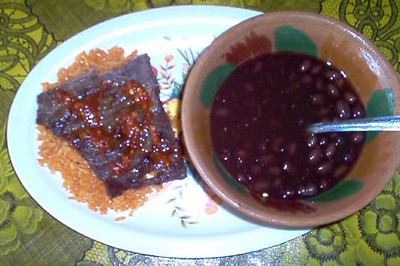
Machaca tacos – beef, pork.
The tacos de machaca are special types of tacos made from salted and dried meat (usually beef), that later gets re-hydrated just before cooking. The drying process happens in the desert, under the hot sun. The typical spices are salt and garlic.
The preparation comes from the state of Chihuahua. People there in the north, love to eat tacos de machaca with eggs for breakfast.
The taste is similar to jerky meat.
In the north, they prefer to prepare burritos, rather than tacos. The burritos are bigger breads, from wheat tortillas, that are wrapped around.
Garnish – onions, cilantro, lime, radish, avocado and sauce.
Tortilla – wheat.
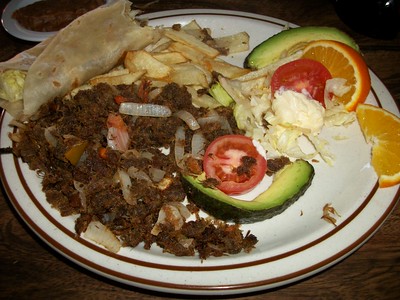
Chorizo/longaniza tacos – meat beef, pork.
Tacos de chorizo or tacos de longaniza are some of my favorite. They are sausage tacos. Chorizo is premium-quality sausage (ground meat), while the longazina (minced meat) is second-quality, but both are very tasty. They have amazing spices like oregano, cumin, coriander, and chili peppers. You can find them in most of the taquerias (taco stands).
Garnish – nopales (cactus), onion, and lemon.
Tortilla – corn or wheat.

Moronga tacos – beef, pork.
The moronga looks very similar to the chorizo, but it is darker. The color comes from the fact that it is made of blood. It has a very strong taste, that is not liked by many, including me.
Garnish – nopales (cactus), onion, and lemon.
Tortilla – corn or wheat.

Campechano tacos.
Tacos Campechanos are mixing two great tastes – tacos de bistec with the tacos de chorizo. You can enjoy both steak and sausage in each bite! These tacos are amazing! As you can imagine, they are a bit more expensive, but if you are a real player, they are perfect for you
Put some cilantro and onions on top and a line of red sauce and taste paradise.
Garnish – onions, cilantro, and lemon.
Tortilla – corn or wheat.

Suadero tacos – beef or pork.
The suadero tacos can be made from beef meat or pork meat, depending on the state of Mexico you are in. The meat itself is very similar to the bistec. It is again a flank steak, but this time the difference is the method of cooking. Suadero is prepared inside a lot of lard. The more greasy it is the better! This one is not for people on diets.
People in the capital loved them, especially in the late hours, after leaving a bar.
Garnish – onions, cilantro, and lemon.
Tortilla – corn or wheat.

Carnitas tacos – pork meat.
Tacos de carnitas are pork meat tacos, from fatter cuts, cooked in a lot of oil. In such a taco you can find any type of parts from pork, even things like nose or tail!
They originally come from the state of Michoacán, but now you can find them in almost every state. It is a very beautiful state, near Mexico City.
For those of you, who are not very adventurous, it is better to skip this one.
Also, as you see, these tacos are very oily and they are not good for your health and diet.
Garnish – onions, cilantro, lemon, sauce, and avocado.
Tortilla – corn or wheat.

Barbacoa tacos – sheep or goat meat.
The traditional barbacoa tacos are prepared from really slow-roasted meat from sheep or goats. The meat stays in fire pits for hours, before it became extremely well cooked. At that moment, it can drop down from the bone without any effort.
You can find this type of tacos in small-town celebrations, important events like weddings, or another occasion with a lot of people.
Of course, you can find them in many taquerias in Mexico City too, no matter what day it is.
The tacos de barbacoa are very popular in the state of Hidalgo, where the people eat them accompanied by a soup (consomé).
Interestingly, these hard-to-cook tacos are mostly consumed in the mornings. In many places, you can’t find them after 2 pm.
Garnish – onions, cilantro, lemon, sauce, radish, and avocado.
Tortilla – corn or wheat.
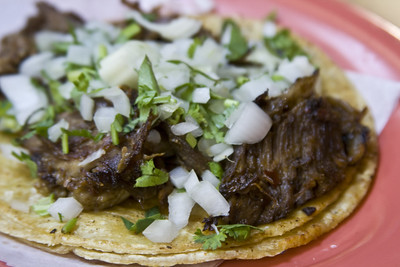
Birria tacos – goat or beef meat.
The birria tacos come from the state of Jalisco. The birria is a type of stew, usually made from goat or beef meat. The spices that you can find in a typical Mexican birria are adobo chilli, onion, and garlic. Thanks to the adobo, the meat has a red color, so, in some places, they are called red tacos.
For some people, tacos de birria are considered low value, mostly because of their connection to drunk people. Mexican believe that eating greasy and spicy birria will remove the hangover.
Garnish – onions, cilantro, and lemon.
Tortilla – corn or wheat.
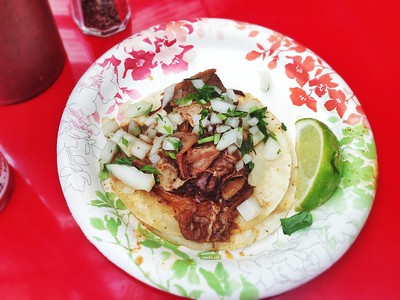
Cochinita pibil tacos – pork meat.
The cochinita pibil tacos of Yucatán, are a must-try if you are visiting Cancún. Cochinita means small pig and pibil shows that they are cooking in an underground oven.
They are made with slowly cooked pork meat, which stays a long time underground in a special oven until the meat becomes incredibly soft. The meat is marinated in citrus juice, made of limes, oranges, and many spices.
It is a bit like the barbacoa, but with pork meat. I prefer this one way more.
Garnish – onions, chile de árbol, habanero chilli.
Tortilla – corn or wheat.
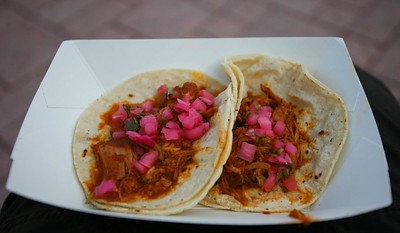
Lechón tacos – pork meat.
The lechón tacos are super similar to the previously mentioned tacos de cochinita pibil. And, as you could guess, they are also from Yucatán.
The tacos de lechón use the same technique for slowly cooking the little pigs. The pigs here are lechones, meaning that they are the youngest pigs (up to 1-month old) that are still eating milk from their mothers.
I didn’t find any differences, nor in taste, or look. Maybe I am not picky enough, but for me is the same meal as cochinita pibil.
Garnish – onions, chile de árbol, habanero chili.
Tortilla – corn or wheat.

Tacos dorados – chicken, potatoes (VEGETARIAN), beef.
The tacos dorados, or golden tacos, are deep-fried tacos with different fillings like boiled potatoes, beef meat, chicken meat, or another. What is special about the way they are served is the fact that they are offered rolled up like a cigar, and on top of them, you get sour cream, fresh lettuce, and white cheese. Depending on the size, they might be called taquitos dorados (small tortillas), tacos dorados (normal tortilla size), or flautas (long tortillas)
If you are a vegetarian, you can get an order of tacos de dorados "de papas". For the vegan, this one does not work, because it is fried and served with sour cream.
Garnish – lettuce, sour cream, white cheese (usually Panela cheese).
Tortilla – corn or wheat.

Tacos de mixiote – beef, pork, sheep meat.
Mixiote sounds very Mexican and it is. It uses an old method of slow cooking in a fire pit, like the barbacoa. Mixiote means mixed and they are a combination of beef, pork, and sheep meat. Perfect for the indecisive people who can’t decide on the type of meat they want.
The meat is cooked with a variety of spices, and chillies, so in the end, you have very juicy meat.
The mixiote tacos are popular in Mexico City, the nearby state of Hidalgo, and also Guerrero (Acapulco).
Garnish – beans, avocado, nopales (cactus), sauce.
Tortilla – corn or wheat.
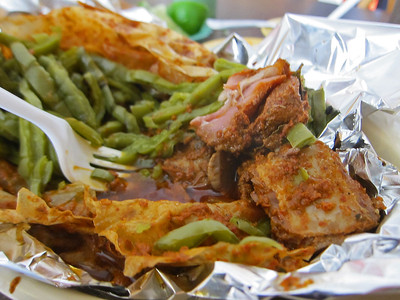
Tinga tacos – chicken meat.
Tinga tacos are chicken tacos, from meat that is shredded to strings. Tinga means torn. What is great about them is that they are cooked with chipotle chilli, tomatoes, and onion and have an amazing taste. It is a simple, yet delicious choice.
Garnish – onions, cilantro, lemon, and sauce.
Tortilla – corn or wheat.

Tacos de Canasta – pork, beef, beans, potatoes, chicharrón prensado.
Tacos de canasta or basket tacos are some of my favorite. You can see the cool guys, going all around the capital city on their bicycles, and selling you straight from the basket.
Canasta tacos are cooked on vapor for many hours, and that gives them their very soft touch.
Some say, that the tacos de canasta come from Tlaxcala state, but you can find them in many states including the capital.
You can find many different tastes:
- Tacos de canasta de frijol – bean tacos with onion. These are 100% vegetarian and even vegan.
- Tacos de papas – boiled potatoes tacos with onion. Another vegetarian and vegan option!
- Tacos de chicharrón – tacos from the fried skin of pigs, cooked in green or red sauce.
- Tacos de chicharrón prensado (compacted or pressed) – frying remains gotten from the bottom of the saucepots where the crunchy chicharrón is fried. These remains are fried again and pressed a little to compact them and remove some of the fat. It is dark brown when it is finally fried.
- Tacos adobados – beef tacos with onion and guajillo sauce
- Tacos de mole verde – chicken meat and green sauce.
- Tacos de picadillo – minced meat, boiled potatoes, and carrots with spices.
- Sauces – salsa verde (green sauce), or salsa roja (red sauce).
Tortilla – soft corn tortillas.
Tip: These tacos take a long time to prepare and go on sale from early morning. Buy them during the day, because in the afternoon, they might not be in their best condition and could be a health hazard.

Guisados tacos – beef, pork, vegetarian (in some cases).
Tacos de guisado are tortillas with different prepared food inside. The traditional tacos de guisado are made of stew from meat and vegetables. Between the many varieties of these tacos, you could try the following:
-
Rice and eggs.
-
Nopales (cactus) and onions. This one is vegetarian and could be even VEGAN!
-
Eggs with tomato sauce.
-
Rajas (chilli) with cream.
-
Picadillo – potatoes, carrots, and minced meat.
-
Chicken with chipotle sauce.
Tip: Always ask what the guisado is. If you are a vegetarian, you might find very good meals. Even vegans might have a chance to eat.
Tortilla – corn or wheat.
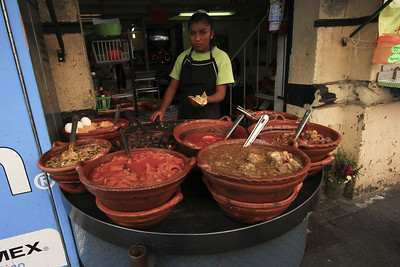
Chicharrón taco – pork meat.
Chicharrón is deep-fried pork skin, that becomes crunchy like chips. The most typical type of taco de chicharrón is prepared in green sauce (salsa verde). The chicharrón becomes soft and incredibly tasty. You can add onion and cilantro on top, to have a perfect culinary experience.
This is one of the not-so-traditional meats, but I can recommend it with two hands!
You can find it made with different sauces like the red one, chipotle, guajillo, and others.
Garnish – onions, cilantro, lemon, and sauce.
Tortilla – corn or wheat.
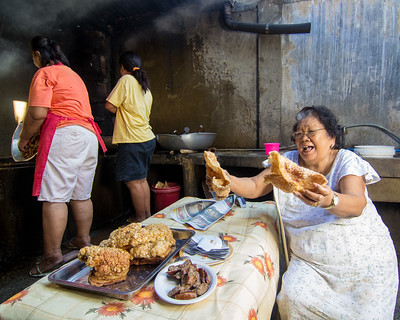
Cabeza tacos – beef meat.
Tacos de cabeza, are made of the meat from a cow’s head. I know, some of you might directly skip this one, but if you insist on trying it, you will get small pieces of meat of chicks, cow’s ears, nose, and more. The only thing that you won’t find here is the tongue, which Mexican separates for another taco (taco de lengua).
So, the head is slow-cooked, in a very big pot with many spices.
I don’t like these ones, but they might be your favorite, who knows.
Garnish – onions, cilantro, and lemon.
Tortilla – corn or wheat.

Lengua taco – beef meat.
If you read the last one, now you know where the cow’s tongue goes, to the lengua tacos. The meat of the tongue is a bit harder to chew and has a very specific texture. It is not for anybody’s taste for sure. For me, it was a one-time try, and honestly, the tacos de lengua were not bad, but you can get better at the same price.
Garnish – onions, cilantro, and lemon.
Tortilla – corn or wheat.
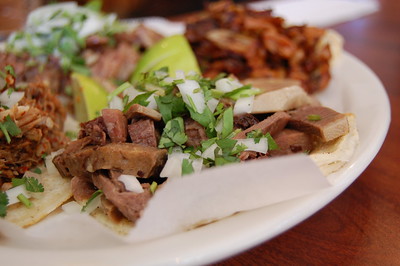
Tacos de panza – pork meat.
Tacos de panza are tacos from the belly of a pig. When you are trying less common parts of animals you always get doubts. The taste is strange, and not everybody likes it, me included. The panza (belly parts) are tough to chew and not very tasty. Such a meal is usually offered with a very strong hot sauce, which further kills the taste.
Garnish – onions, cilantro, lemon, and sauce.
Tortilla – corn or wheat.
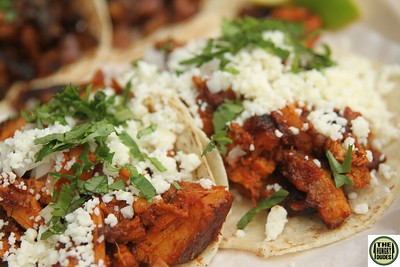
Tacos de tripas – beef meat.
If you didn’t like tacos de panza, you will like tacos de tripas even less. The tripas are intestines of the animal (cow). The intestines are well cleaned, and then boiled for hours. After that, they are cooked in their own fat until they get to a rubbery texture. These tacos are also offered with a very hot sauce.
I personally don’t recommend them. They just didn't taste good for me.
Garnish – onions, cilantro, lemon, and sauce.
Tortilla – corn or wheat.
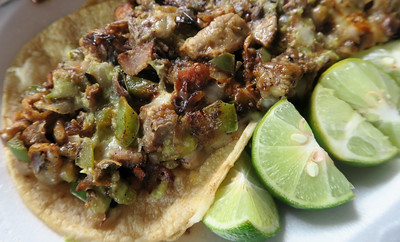
Pescado – fish.
The tacos de pescado are fish tacos. You can find them on every beach place. Cancún (Yucatán), Playa del Carmen (Yucatán), Puerto Escondido (Oaxaca), Acapulco (Guerrero), Puerto Vallarta (Jalisco), Los Cabos (Baja California), and others have their version of pescado tacos. Each place has a bit different method of preparation, but the most common is to fry the fish and add hot sauce. The garlic is also a very common ingredient, together with cilantro, lime, habanero chilli, mayonnaise.
The most common tacos de pescado are:
-
Tacos de Marlin fish (Tacos de pez espada) – smoked swordfish tacos. Expensive, but delicious.
-
Tacos de filete frito de angelito – shark tacos.
-
Tacos de cazón – small shark from Veracruz.
-
Tacos de bacalao – cod fish tacos.
-
Tacos de tilapia – tilapia tacos. You will find this one commonly written as filete, in the menus.
-
Tacos de magro – white fish taco. It could be any of the following acedia, abadejo, besugo blanco, coruxo, merluza, rodaballo salvaje.
-
Tacos de atún – tuna fish tacos.
-
Tacos de salmón – salmon tacos. These are a bit oily but very tasty.
-
Tacos de bagre – catfish tacos.
-
Tacos de mantarraya – manta ray tacos.
Tortilla corn and wheat.
Tip: If you want to enjoy a fish taco, go to the beach. Yes, you can find fish tacos in the capital or any other big city like Monterrey or Guadalajara, but the fish won’t be as fresh as on the seaside.
Also, evade the pescadillas (quesadillas de pescado) that you will see on every beach. The sellers offer them all day, and the sun can really damage them, and poison you when you eat.

Tacos de mariscos – sea food.
Tacos de mariscos unite all of the seafood – fish, octopus, calamari, oysters, etc. Many times, these tacos are a mix of everything that the restaurant has at the moment, so if you want to get more information, ask “¿De qué son?”. Mexico has a lot of seafood. It is on two oceans – the Atlantic and the Pacific. The garnish here is again lime, hot sauces, mayonnaise, onion, avocados, and more.
There are plenty of choices and really fresh seafood. What you can see in the restaurants’ menus are:
-
Tacos de ostiones – oisters tacos.
-
Tacos de calamar – calamari tacos.
-
Tacos de camarón – shrimp tacos.
-
Tacos de pulpo – octopus tacos.
Tortilla corn and wheat.
Tip: Just like the fish tacos, evade seafood tacos if you see that the sellers or the restaurants don’t look like they are keeping the seafood in a proper environment. Eating bad seafood can lead to at least a few days of diarrhea, and that could easily ruin your fun beach trip.
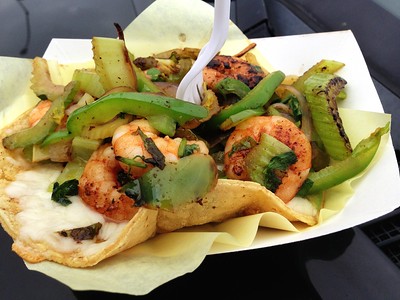
Tacos de chapulines – grasshoppers tacos.
Yes, you read this one right. Mexicans eat grasshoppers! They put them in tacos, add some delicious sauce on top and enjoy a crunchy snack. I have tried these ones and I really like the taste of the grasshoppers. For me, they are like chips with salt and lemon.
Funny story with these tacos de chapulines. One Time I ate some from a food truck in Mexico City and I sent a picture to my grandmother in Bulgaria. She got extremely shocked by the grasshoppers. She told me that if I am so poor that I am eating insects already, it is time to come back.
She said that she will buy me a ticket and cook me whatever I desire!
Garnish – onions, cilantro, avocado, sauces.
Tortilla – corn or wheat.
Tip: If you don’t feel brave enough to try, just close your eyes and imagine they are deep-fried potatoes.

Tacos de maguey – maguey worm tacos.
Sure, why not? If Mexicans eat grasshoppers, what could stop them from eating worms too? The maguey worm eats agave plants. This is the reason that you can see these tiny worms inside tequila and mezcal bottles. The Mexican thought, if the worms eat just agave and we already put them inside our drinks, why not put them on our pans? They deep fry the maguey worm with spices and lime and serve it inside a tortilla with guacamole sauce.
It is not for anybody’s taste, but if you are passing through Oaxaca or Jalisco, it won’t kill you to try tacos de maguey.
Tip: If you like alcoholic drinks, you can get a shot of tequila or mezcal to get the courage to try the worm tacos!

Tacos de escamoles – insects eggs tacos.
The escamoles are insect eggs, mostly ant eggs, and people called them the Mexican caviar. It sounds really strange to eat ants eggs, but you can imagine that there are a lot of proteins inside them. They are prepared with spices and butter and are considered an expensive delicacy.
I have tried them, and I can say that you mostly taste the spices, and the eggs feel just like a small exploding ball inside your mouth. Try, if you want to brag that you have tried everything, otherwise, there are far more delicious options for tacos.
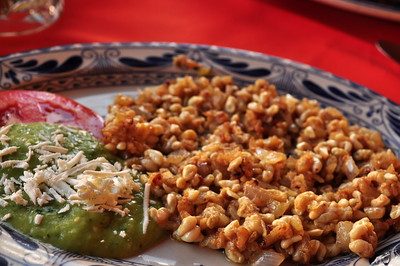
Tacos de ahuatle, huevos de mosco – mosquito eggs tacos.
Ahuatle or huevos de mosco are eggs of mosquitoes, the annoying insects that bother you while you are trying to sleep. Eating their eggs inside a taco could be nice revenge! I tried tacos de ahuatle in Xochimilco in Mexico City, and I didn’t like them at all.
How to choose the best Mexican tacos?
-
Don’t buy tacos, or any other Mexican food inside, or near a metro station. The quality there is very low, and it is not worth trying. Yes, you can get a few tacos for less than 50 pesos, but that comes in a price of stomach pain, and hours in the toilet. Besides, you can get a very bad impression of what Mexico can offer.
-
Most taco stands and authentic small restaurants are fine. You can eat without worries about your health. If your belly is really delicate then go to a big Mexican restaurant or any of the restaurant chains like El Porton, Potzollcalli, Vips, Toks, El Tizoncito, or Sanborns.
-
Try the chilli sauce, before you spread it all around your dish. Many times, the hot sauce could be really strong. Especially if it is chile de árbol or chile habanero. Try before, so you don’t cry later!
-
Don’t eat tacos de canasta in the afternoon. I am speaking here from experience. Once I ate some tacos de canasta de chicharrón and my belly was hurting for days! The taco de canasta sellers go out early in the day, and they don’t keep their tacos in a fridge. Just in a normal basket. Mexico is hot so you can get all kinds of intestinal infections.
-
Ask the locals. When you are visiting Mexico, you must get to know the local people. They are incredibly friendly and always ready to help a tourist. Ask them, which are their favorite taco places, and in many cases, they will be happy to show it to you.
Conclusion.
Wow! There are so many types of Mexican tacos out there! My favorite are tacos al pastor, especially after leaving a nightclub. But also I love tacos de bistec, tacos campechanos, and tacos de cecina. It is a shame that you can’t find true tacos outside of Mexico.
Now that you can finally understand the menu in a Mexican restaurant, which one are you eager to try? Don’t be shy, get your order now. And put some sauce on them!
Share your experience with us, PackandGo.info
| Follow PackAndGo.info at: | |
| YouTube | @packandgo. |
| @packandgo.info | |
| X | @packandgoinfo |
| Bluesky | @packandgo.bsky.social |
| @packandgo.info | |
| TikTok | @packandgo.info |
If you want to know more about the tacos see this article "Everything you wondered about tacos, answered".
Please, do not visit the beaches near Kavala City!
- Details
- Written by: Gianna Esquivel
- Hits: 2951
Greece is such a nice country to spend as much time as you can. No matter where in Greece you are, you always will find a nice spot to eat, a cozy place to stay, a beautiful hidden beach to enjoy, and a cool Greek to chat with. Exploring Kavala City has been very pleasant and exciting! Now, we are curious about its surroundings; the beaches near Kavala City. We decided to pack and go again to discover what else can we enjoy.

If you spot Kavala on a map, it is not hard to realize that is mostly surrounded by beaches and small towns. This is so far one of the most relaxing travels we have made and we don’t mind at all! M and I thought: “If the challenge here is to move from beach to beach every day, perfect! We can do that!” hahaha. We are the type of travelers who instead of taking it easy, walk to death daily to explore as much as possible. Usually, we finish very tired every day. Perhaps, for the first time, we will rest during a trip so we won’t need a break after the holidays! It gets a vicious circle, guys hahaha
Where is Palio?
Palio’s full name is Palio Tsifliki. Get your map and you will see Palio in northeastern Greece, along the coastline of the beautiful Aegean Sea. It is about 9 kilometers west of Kavala City center. Driving (Via EO2, Greek National Road 2), it will take you around 15 minutes to reach it, based on Google’s calculation.
The Via EO2, Greek National Road 2 is a very long road located in the regions of West, Central, and East Macedonia, and Thrace. It connects the Albanian border close to Florina with the Turkish border close to Alexandroupoli. Just following this road could be a cool adventure full of nice places to enjoy.
We have been very lucky because we haven’t found heavy traffic (May 2023). Driving around Northern Greece has been a pleasant experience. The fact that is not high season yet must be a reason. With all the accommodation choices we have seen around, for sure during Summer, traffic increases considerably.
You also can take a KTEL bus from Kavala to Palio Tsifliki. It departs from the Kavala bus station and the fee is around two euro.
What to do in Palio?
Today, we did not drive too long. It only took us 9 kilometers and 15 minutes to reach this small western suburb of Kavala. Palio is a popular recommendation because of its beautiful beaches, clear waters, and chill-out atmosphere. It is a nice destination enjoyed by tourists and locals. For Greeks living in Kavala City, Palio is a nice escape when they want a break from the city's buzz. For tourists, Palio is a quiet and comfortable extension of soft and sandy beaches that gives the perfect excuse to stretch your holidays and enjoy another angle of the Aegean Sea. The beaches in Northern Greece are amazing!

Don’t expect a common and massive resort because Palio is not that. It is more like a cute village and it has everything you need to have a nice and relaxing staying. Palio does not have a typical town design. You won’t find a center surrounded by streets. Palio’s design has been defined by the houses, hotels, guesthouses, villas, taverns, bakeries, mini markets, pharmacies, and shops that have grown on both sides of the main road that passes through the suburb (EO2 road), all along the coast.
Relaxation and beach exploration
What to do in Palio? This is our main recommendation: explore the beautiful coast and relax! Beach sand in Palio is soft and the water is shallow around the shore. There are some areas where the beach zone is small or narrow, but we always have found space for our umbrellas. Locals told us that in the high season, several bars are installed on the beach, so a part of the beach space is taken by the sunbeds and parasols offered by these bars or the beachfront hotels to tourists. Right now (May 2023), there are no such amenities so the complete beach is for a couple of other tourists, us, and our umbrellas, and that is fantastic, guys!
You can walk on the beach until you find your perfect spot. Then, it is up to you, to swim, sunbathe, enjoy paddle boarding or snorkeling. Maybe take a break in your accommodation, treat yourself with Greek food, coffee (cold or hot), a glass of Tsipouro or Ouzo (nice Greek beverages), and get back to the beach to enjoy a great and romantic sunset.

Palio exploration can lead you from the beach (the best place to be) to the small background of the suburb where you can walk and find different taverns, a little playground, and the Holy Church of the Assumption. No big sightseeing places within walking distance in Palio, but having that sea, who needs more? We are on one of the best beaches in Northern Greece and crowd-free! Priceless!
How long to stay in Palio?
If you want only to see what’s Palio about, a couple of days are enough. If you have more time, a week here can recharge you to get back home and retake your routine.
| Follow PackAndGo.info at: | |
| YouTube | @packandgo. |
| @packandgo.info | |
| X | @packandgoinfo |
| Bluesky | @packandgo.bsky.social |
| @packandgo.info | |
| TikTok | @packandgo.info |
Where is Nea Iraklitsa?
Let’s go back to your map. Nea Iraklitsa is about 16 kilometers west of Kavala City center. Driving (Via EO2, Greek National Road 2) will take you from 20 to 25 minutes, based on Google’s calculation. If you drive from Palio to Nea Iraklitsa as we did, it takes only 10 minutes and 6.6 kilometers (said Google).
You also can take a KTEL bus from Kavala to Nea Iraklitsa. It departs from the Kavala bus station and the fee is around three euro.
What to do in Nea Iraklitsa?
Nea Iraklitsa is another beautiful gem on the Aegean seaside. Its design is different from Palio’s. It is a small town but you can spend complete days just walking and exploring its bay, the small port for fishing boats and yachts, taverns, cafes, and bakeries. Accommodation offers you many different options and most of them are very close to the beach.
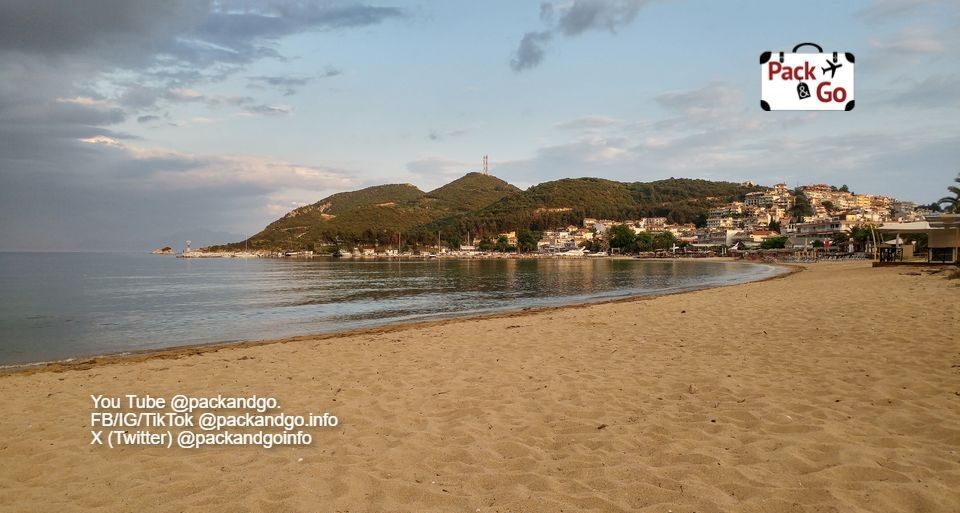
Nea Iraklitsa exploration
What to do in Nea Iraklitsa? You have two areas to explore in Nea Iraklitsa, the village where locals live, its center, and picturesque streets built on a hill overlooking the sea. The tourist area all along the beach its multiple villas, hotels, guesthouses, bars, supermarkets, and taverns. Besides the main road, there is a nice promenade where people can calmly exercise and walk while enjoying the landscape.

It is a very comfortable and relaxing spot where the variety of restaurants, bars, and coffee places is bigger than in Palio. No matter the short distance between these two coastal spots, the landscape is different. Yes, you have again stunning beaches, a lovely and relaxing atmosphere, and impressive clear waters, but you won’t feel you are staying in another exact Palio’s copy. You have to explore Nea Iraklitsa in the morning, midday, and during the evening. It is in general a very calm and relaxing place, however, in the evenings it also offers some party vibes. Live music, Greek and Turkish singers, and their danceable or romantic rhythms set the tone for those who also want to move their bodies and enjoy the night. Still, it never reaches the buzz and alcoholic party levels of those massive resorts we all for sure have visited. It is very enjoyable during the day and night!
Beach relaxation
Take your bathing suit, sunblock, sunglasses, and sandals and drop somewhere on the beach just to take some sun, a nap, and swim as long as you feel like in the awesome Aegean Sea. During our stay, we never saw strong currents or waves. The sea is shallow so it feels pretty safe to swim there. Psatha and Remvi are two small beaches you should visit behind the port. You can rent a sunbed or it can be provided by your accommodation free of an extra charge, be on a terrace of a bar, or take a walk on the sandy beaches to have a great day. All your senses will be indulged with the natural beauty of Nea Iraklitsa, one of the best beaches in Northern Greece!

Fishing
Nea Iraklitsa is another great place for fishing enthusiasts. Take your equipment and pick your favorite spot for fishing while enjoying the very calm dance of the waters. There is a chance to join local fishermen or rent a fishing boat to have the experience and catch your dinner!
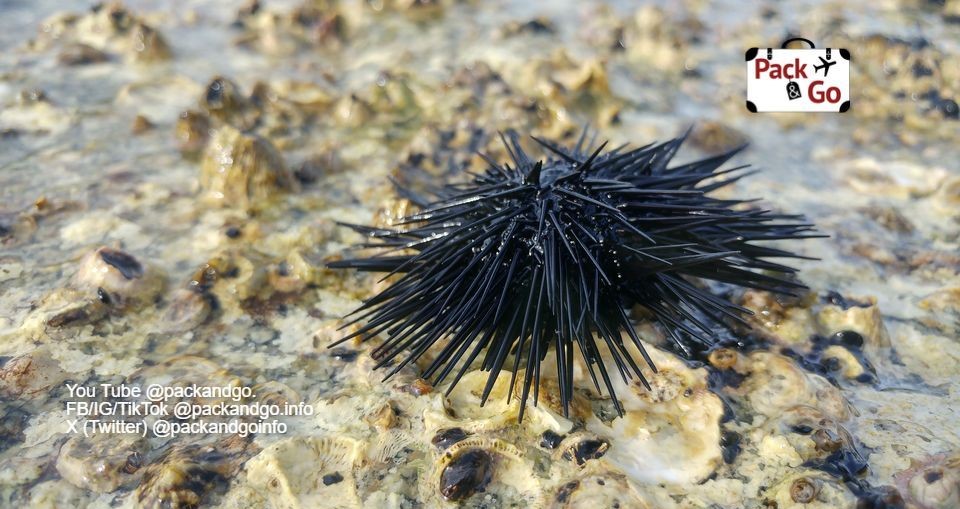
Camping
In Northern Greece is not hard to find campsites to park your vehicle (van, camper, or regular car) and stay there without worries, having access to services like showers, electricity, or Internet, and sharing time and conversations with other visitors. In Nea Iraklitsa, the campsite could not be better. It is exactly in front of the beach. Besides, there is a car park (free, at least during the low season) where you can comfortably park your vehicle without any worry and enjoy the whole day, if you want, on the beach. We found out a big community of van life fans. They gather both, at the campsite and the car park, especially during the evenings. The environment is very nice. Tourists mostly from Polland, different Bulgarian cities (Varna, Sofia, Plovdiv, Kardzhali, etc.), and Turkiye were having a great time while preparing the grill, cooking, and watching the sunset all together. Some were cooking the fish they fished so fresh food from the sea to their plates, cooking in front of the beach. That is life!
Water Sports
During the high season, the offer of more services like snorkeling, windsurfing, jet skiing, or paddleboarding is added to the variety of things to do in Nea Iraklitsa. It is not hard to get such services because they are offered by the vendors on the beach or even at your accommodation.
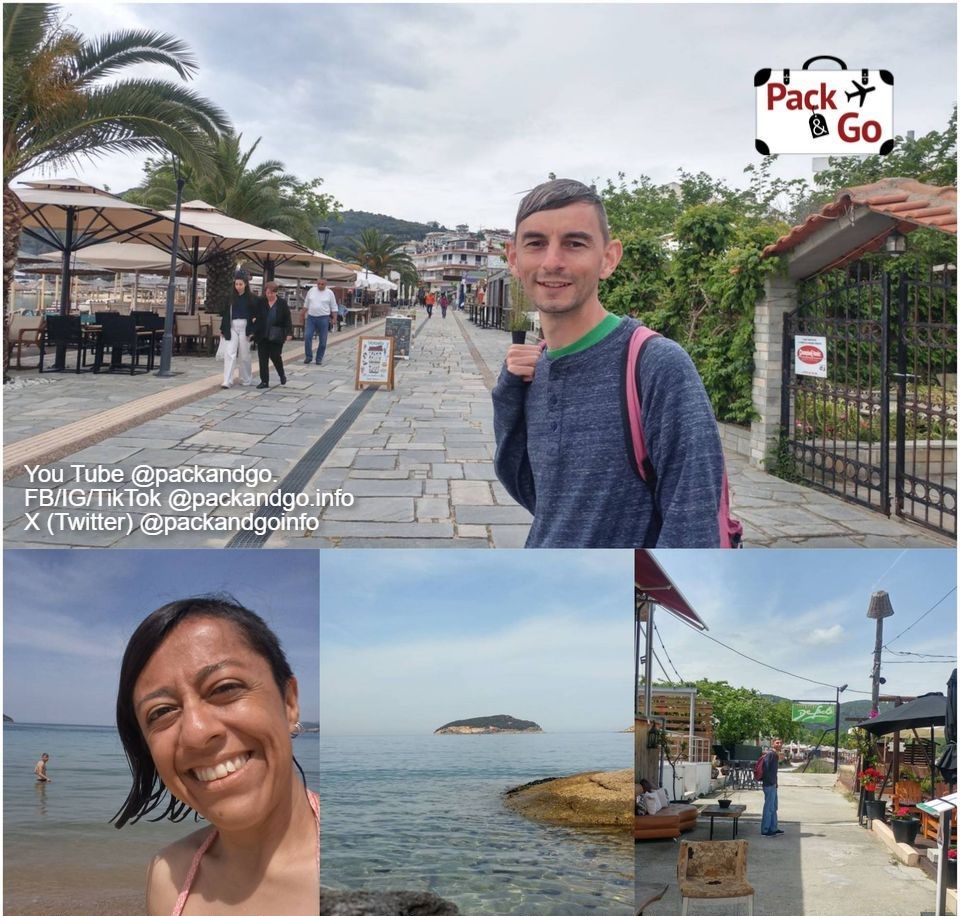
Boat tours
The small but active port of Nea Iraklitsa is the place to hire a boat for you to drive or pay for a boat tour. On such a tour, you can explore nearby islands or hidden coves, and enjoy from a boat the beauty of the Aegean Sea.
Eating Greek cuisine
We won’t be repetitive. Just remember Northern Greece and its beautiful coast gives you a priceless chance to try fresh seafood and traditional Greek dishes. In Nea Iraklitsa we tried some of our favorite souvlaki and moussaka.

How long to stay in Nea Iraklitsa?
From a weekend to a week and even more, could be ok. Here you can combine days of doing nothing more than swimming and enjoying the beach, with days of more activity because Nea Iraklitsa’s offer is bigger.

Where is Nea Peramos?
Nea Peramos is located 22 km (27 minutes by driving) west of Kavala City center. It is 3.5 km or 7 minutes away from Nea Iraklitsa. You can reach it by taking the via EO2.
You also can take a KTEL bus from Kavala to Nea Peramos. It departs from the Kavala bus station and the fee is around four euro.
What to do in Nea Peramos?
Yes, we only drove 3.5 km hahaha. Exploring Greece at this pace can take you a life, but we don’t mind! You will agree when you come, you will see.
Nea Peramos is another charming coastal town in northern Greece, well known for its scenic views and of course, beautiful beaches. Visiting Greece is to step into ancient history and cultural and archeological treasures. You can learn a lot here and visit many museums or archeological zones. But you also can have very relaxing holidays just enjoying the marvelous beaches all around the country and its many islands. You can also combine the two experiences, so Greece gives you plenty of choices to stay longer or get back several times.

This town’s design is similar to Nea Iraklitsa’s. The main road (via EO2) passes exactly in front of the beach and the shops, hotels, and taverns, but there is a long nice promenade for you to walk without worries and be even closer to the Aegean Sea. Nea Peramos is a town where many Greeks live, work, and study daily. They share their town with the tourists that every year come here to have fun and relaxing time. After spending more than a few days there, you can realize that many businesses are run by families, people know each other, and this makes a cozy, familiar, quiet, and safe environment.
Nea Peramos has everything you need to stay there. Accommodation (different sizes of rental departments, hotels, and villas), restaurants, taverns, shops, and some of the best beaches in Northern Greece!
What to do in Nea Peramos?
Beach relaxation
You know, swimming, sunbathing while napping, reading a book, or chatting with locals.

Water Sports
If you want more exciting experiences, practice snorkeling, windsurfing, jet skiing, or paddleboarding. A note for you, snorkeling is very easy here. You can directly jump into the water only wearing your snorkel mask and you will see many cool and colorful fish thanks to the sea’s clarity. They swim just next to you and it is beautiful! But ok, a paid service can take you deeper into a beautiful reef.
Boat tours
People like a lot to rent and drive boats. This choice is available or you also can be only a passenger on a tour.
Eating and drinking Greek stuff
We ate some of our favorite gyros here in Nea Peramos in a small, local, and full of nice food and people place. Try different foods and places until you find your favorite. Money and time spent on trying local dishes is always worth it!

Sunset spotting
This is one of our favorite activities so far. We stayed in a very comfortable apartment with a balcony. The place was in front of the beach. It was 40 EURO per night (May 2023). From there we had a great view of the main street, the beach, and the island Thasos was visible from there too!
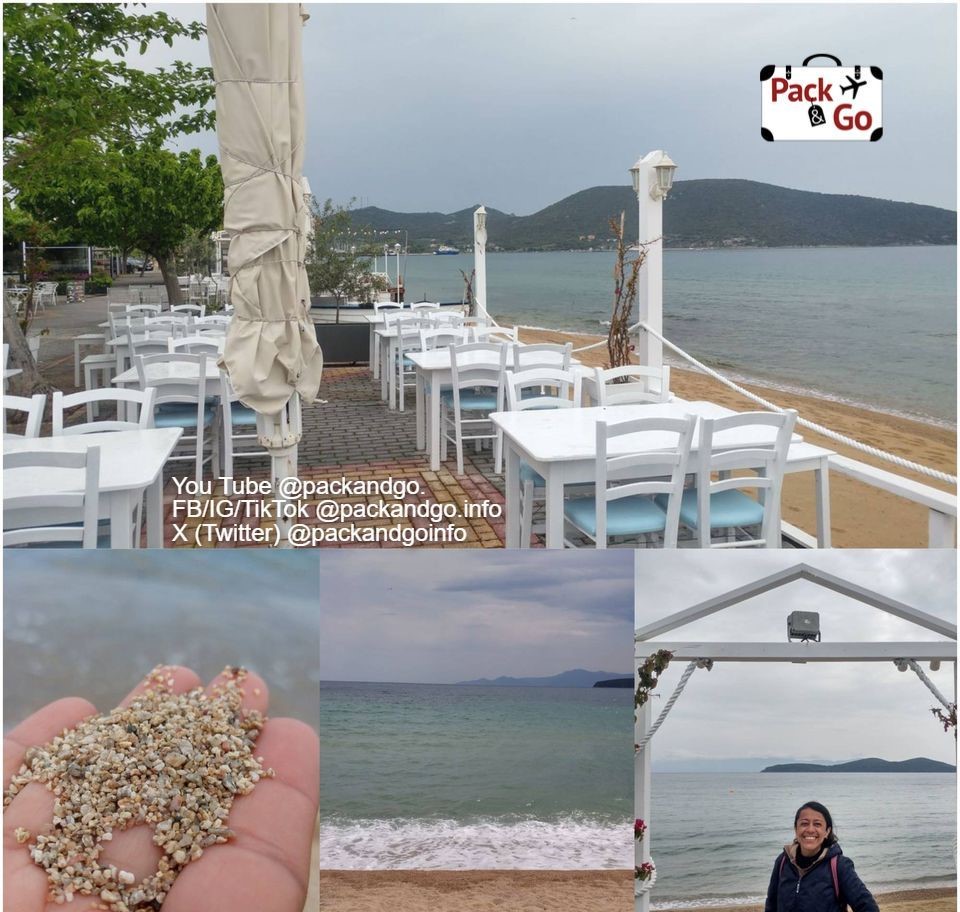
Visit Anaktoroupolis Castle
You can visit the castle of Anaktoroupolis and see its ruins (byzantine time). You can easily spot this attraction from the Nea Peramos beach. The ruins are exactly on the top of a slope leading towards the sea.

Go to Thasos Island
Being at Nea Peramos will put you in front of a hard-to-resist temptation: Thasos Island. There is a port in the town and locals told us they have been asking to reopen the ferry route Nea Peramos-Thasos that once operated. If you are lucky and the port opens and operates this route again, you could have a great choice right in front of you.
How long to stay in Nea Peramos?
A weekend, a week, and even more could be ok. Nea Peramos is another good place to mix days of only beach time, with days of a bit of effort. A perfect combination to recharge yourself and get back to your regular life.
Where is Ammolofoi Beach?
Ammolofoi Beach is located 26 km (33 minutes by driving) west of Kavala City center, based on Google’s calculation. And it is 5 km or 9 minutes away from Nea Peramos. It can take less, it depends on the exact part of Ammolofoi you visit. It is a long beach.
The KTEL bus we have been mentioning only reaches Nea Peramos. We were told that during high season, there are vans that take people from there to Ammolofoi but when we were (May 2023) there, this service was not available yet. We drove there.
What to do in Ammolofoi Beach?
Greek people told us we must visit one of the best beaches near Kavala City, and of the complete Greece, and they were not kidding. So we went. Ammolofoi in Greek means “dunes”. It is a very wide and long beach, at least 3 km beach. There is not such a wide beach in the previous destinations we visited (Palio, Nea Iraklitsa, Nea Peramos). You will find some rocky spots that are used as a reference to divide and locate three areas known as first, second, and third Ammolofoi (from east to west).

Thousands of tourists visit this beach every year to enjoy its clear and shallow waters, but also its party vibes. Yes, here you are on a different type of beach. While in the previous stops relaxation and quietness are the notes, people come to Ammolofoi to party, dance, drink, and have fun with other locals and tourists.
If you search on the Internet, Ammolofoi is truly considered one of the best beaches not only in the northern but in complete Greece. That is not minor if you consider the beauty in terms of beaches this country offers.

All along the beach, you can find beach bars providing tourists with umbrellas and sunbeds. You can swim, drink a coffee or another Greek beverage, and eat snacks and local dishes while having in the background the notes of electronic music and other rhythms to dance. In front of you, is the endless blue of the Aegean archipelago. When weather conditions collaborate, you can see from Ammolofoi, the island Thasos, and the mountain Athos (Halkidiki). If too much party is not for you, there are some quieter spots in Ammolofoi Beach. You only have to walk until you find your ideal place.
We visited Ammolofoi before the high season and it was not crowded, not so noisy, and very enjoyable. Please, do not visit Ammolofoi! Leave it like this, only for us!
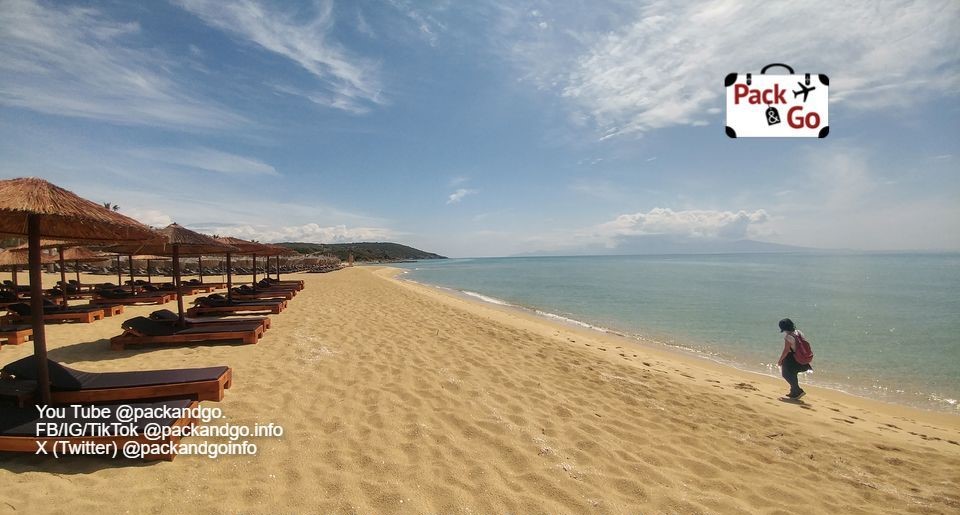
How long to stay in Ammolofoi?
It depends on where you stay. We saw a campsite and several villas close to Ammolofoi Beach, but not many accommodation choices nearby (meaning walking distance). If you get a place exactly there you can stay as long as you feel like. But if you are staying in Nea Peramos or another town in the surroundings, you can go to Ammolofoi as many times as you want but that does not mean to literally stay there.

What else to do on the best beaches near Kavala City?
We recommend you what to do in every destination (Palio, Nea Iraklitsa, Nea Peramos, and Ammolofoi Beach), but if you have time to go further, you can go to some interesting attractions like:
Explore Alistrati Cave
This is a large cave, 3 km long, full of stalagmites and stalactites. From Palio, Nea Iraklitsa, Nea Peramos, and Ammolofoi Beach, it will take you approximately one hour and twenty minutes (maximum) to reach the Alistrati Cave.
Visit Ancient Philippi
If you did not visit Philippi while staying in Kavala, you still can do it from these destinations. You will be 30 km (30 minutes) away as a maximum. Ancient Philippi is a UNESCO World Heritage Site. You can visit the theater, Roman forum, basilicas, and more remnants from Roman and Byzantine times.
Hike the Pangaion Mountain
Pangaion Mountain is approximately 40 km from Kavala. From Palio, Nea Iraklitsa, Nea Peramos, or Ammolofoi the distance is pretty similar or a little bit less. The highest peak (Koutra) is 1,956 m. Climb it and discover its great views and nature, and have a look from the top to the Aegean Sea. If Pangaion conquers you, there is a very cozy place where you can spend the night or more days. Pangeo Forest Village is 10.93 km from Pangaion Hills. Ask for Eleftherios, he runs the place and you can have the best time there following his recommendations and chatting about Greek history.

Visit Drama
Drama City is another choice if you want to combine your beach holiday with some history and even a wine tour. You can drive to Drama and it will take you from 40 to 50 km (one hour approximately) to reach it.
Explore Kavala
We started our exploration in Kavala (east to west), but if you arrive in northern Greece from west to east, you can visit Kavala, its historic old town, the fortress, port, etc.
Please, do not visit the beaches near Kavala City!
If you have been to the most popular Greek destinations, you know how is to be in a paradise fully packed with tourists every year. For us, to be smashed with others like canned sardines is nightmarish.
The Northern part of Greece has been a very pleasant experience because it is beautiful and it is like a hidden paradise kind of reserved mostly for Balkan visitors. There are tourists of course, but not the crazy figures Athens, Santorini, or Mykonos register.
Seriously, do not visit the beaches near Kavala City! Leave them for us! It is fantastic not to share the beauty of these beaches with others.
Conclusion
Greece is a country you should explore as much as you can. All your senses will deeply appreciate the constant repetition of the experience. Follow our adventure and let's explore together the next stop!
| Follow PackAndGo.info at: | |
| YouTube | @packandgo. |
| @packandgo.info | |
| X | @packandgoinfo |
| Bluesky | @packandgo.bsky.social |
| @packandgo.info | |
| TikTok | @packandgo.info |
Check more interesting articles about Greece:
Why do young people dislike Kavala?
It is official, Fanari has been occupied by Bulgaria!
Kardzali is a hotspot for Turkish and Greek tourists, but not Bulgarian. Why?!
Keramoti: The Beach Town You’re Not Visiting—And It’s Better Than Santorini!
- Details
- Written by: Gianna Esquivel
- Hits: 2548
Previously in Pack and Go: we have just finished our adventure in Thasos. We took the ferry to get back to the mainland, and there, we had a second encounter with Keramoti. We were there for the first time only to take the ferry and go to Thassos. This time, when we dropped by there, we decided to stay for a few days to explore the town! Most people reach Keramoti only to board the ferry, but is it worth a visit? Let’s find it out!

Where is Keramoti?
Keramoti is a small town located in the Eastern Macedonia and Thrace region of northern Greece. Get a map and search for it! Keramoti is positioned on a little sort of peninsula or promontory, near the Nestos River Delta, and is surrounded by lush landscapes, and a wide and long sandy beach bordered by pine groves. It serves as a gateway to the natural wonders of this region.

Its strategic location, sitting along the Thracian Sea directly opposite the island of Thassos, makes it an essential hub for ferries traveling to Thassos. However, it also offers a peaceful retreat from the crowds of Greece’s more famous destinations.
How to reach Keramoti?
Getting to Keramoti is straightforward, thanks to its proximity to major cities and transportation networks. The most viable option for you will depend on where you come from.
By Air
The nearest airport is Kavala International Airport "Megas Alexandros" (KVA), just 12 kilometers away. Flights connect to Athens and some European cities. From the airport, you can take a bus to Kavala City, where you can take a second bus to Keramoti. Other choices -more expensive and faster- are available: taxis, private transfers, or rental cars. It is up to you.
By Ferry
If you are coming from Thassos, ferries connect Keramoti to the island’s port in Limenas. The journey is short, lasting around 35 minutes, with frequent departures throughout the day.

By Public Transport
Local buses from Kavala and Xanthi connect to Keramoti, only ensure you check the available schedules.
By Car
This time, this was our choice. We are driving. Based on Google’s calculations:
From Kavala City, Keramoti is about 40 kilometers east of Kavala, accessible via Egnatia Odos/A2/E90. The ride should take approximately 40 minutes.
From Thessaloniki, it takes 200 kilometers, so around 2 hours and 30 minutes.
What is the origin of the name Keramoti?
Keramoti is derived from the Greek word "keramos," meaning clay or pottery. Historically, the region was known for its clay-rich soil, which was used in pottery and ceramics. This connection to natural resources hints at the village’s humble origins as a place of craft and industry.
| Follow PackAndGo.info at: | |
| YouTube | @packandgo. |
| @packandgo.info | |
| X | @packandgoinfo |
| @packandgo.info | |
| Bluesky | @packandgo.bsky.social |
| TikTok | @packandgo.info |
A Short History of Keramoti
Keramoti has a modest history compared to Greece’s ancient cities. Originally a fishing village of Greek immigrants from Asia Minor, it grew due to its location near the Nestos River Delta, a fertile area that supported agriculture and trade. Over time, the village became a small port, connecting mainland Greece with Thassos.
While Keramoti lacks grand historical monuments, it offers a glimpse into the evolution of a traditional Greek coastal village, untouched by the rapid tourism development seen in other areas.
Can you stay in Keramoti, or is it only a port?
Contrary to its reputation as only a ferry hub, Keramoti is a cool place to stay. The village offers from cozy family-run guesthouses to apartments and small hotels. Staying in Keramoti allows visitors to enjoy its tranquil beaches, authentic Greek cuisine, and natural surroundings without the rush of larger tourist destinations. Besides, you can easily visit Thasos, Kavala City, and other beautiful surroundings from here.

Our decision to stay in Keramoti was made beforehand, but exactly as we were getting off the ferry, a cute sunset greeted us and confirmed that decision! Sunsets in Greece are something you should enjoy at least once in your life!

What to do in Keramoti, Greece?
Being in a village, we knew that simplicity was key to understanding the available activities there. The first afternoon in Keramoti we easily found the apartment we rented and walked around the town to have a night view and enjoy local food and drinks. The next four days, our holiday routine added activities like the following.
Relax on pristine beaches
If you have followed our adventure in Greece, you already know that enjoying the Greek beaches has fascinated us! It has become our favorite activity. We have already visited many beaches and we still crave more!

Keramoti’s sandy and wide beach stretches for kilometers, offering calm, shallow waters ideal for solo travelers, couples, and families looking for relaxation in a quiet environment. The beach was not crowded during our visit (beginning of June), making it perfect for sunbathing, swimming, and unwinding. Beach bars provide sun loungers, umbrellas, and refreshments, blending relaxation with convenience.

Keramoti offers you cool options to balance between calm beach areas where you can only hear the sea waves (the more remote) and others where you can enjoy music, a conversation with locals or other tourists, and some drinks. Still, it is not a noisy or party destination. Fortunately for us!
Fishing and boating
Keramoti remains a fishing village at heart. You can join locals for fishing excursions or rent a small boat to explore nearby waters. Greeks are really friendly and talkative. If you want to get the best out of staying in Keramoti, forget shyness and talk with them. Locals have the best advice to make your holidays more fun and to indulge your belly and complete senses with the most delicious choices, like the fresh fish they catch.

Explore the Nestos River Delta
If you are a nature enthusiast, you can take guided tours of the Nestos River Delta, a protected wetland area rich in wildlife and rare birds. Kayaking, canoeing, and hiking are popular ways to explore this ecological haven.
Try local cuisine
As you expected, seafood is a highlight in Keramoti. Visit local tavernas to enjoy fresh fish, octopus, and mussels caught daily. Pair your meal with a glass of ouzo or local wine for an authentic experience. This can become fast a hard-to-quit pleasure!
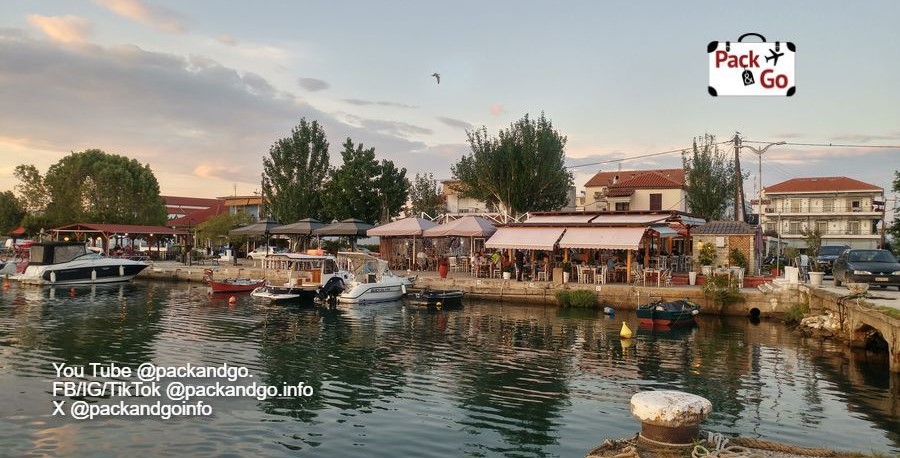
We realized that we have slowed down considerably our eating pace hahaha Being in Greece there is nothing like a hurry meal experience. Once you get a cool spot in a taverna, your eyes and thoughts can get lost in the views of the sea. You won’t realize the time passing until your nose gets hit with the luscious aromas of the meals arriving at your table. Bite by bite, sip by sip will come together in a harmonious symphony you won't want to end! And later on, a glass of ouzo and a coffee will follow perhaps, at the time a beautiful sunset announces you again the time you have been there. Guys, we absolutely recommend you come to Greece and try Greek cuisine!
Day trips to Thassos
The ferry ride to Thassos makes for an excellent day trip or a whole week visiting the beautiful island. It really depends on the time you have. Thassos offers modest ancient ruins, vibrant villages, stunning beaches, and more. You can read about our adventure there! It was hard to leave Thasos! However, that led us to Keramoti and we are not exactly suffering here haha Keramoti is offering us an extra cool chapter for this trip. This town has everything you need to have a relaxing holiday.
Taking the ferry to go and get back from Thasos is easy because you are already at the port (Keramoti).

What to visit in Keramoti?
Keramoti might not have monumental landmarks, but it boasts natural and cultural attractions.
Keramoti Beach
The village’s main attraction, this beach is perfect for families and those seeking a peaceful seaside experience. As we said before, Keramoti’s sandy and wide beach stretches for kilometers. That ensures you will find your perfect spot.
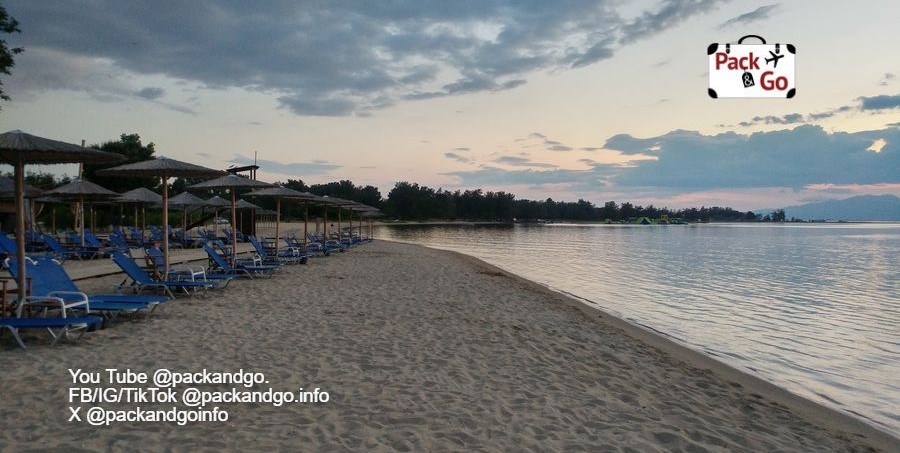
Here we share a fun fact. Many tourists told us they loved Greek beaches because of their nice sand, thrilling colors, and shallow waters. Some young couples mentioned that shallow and calm waters are perfect not to risk their young something kids' safety. Others agreed but added that the absence of strong currents and waves is also good for adults like them who don’t know how to swim! We laughed a bit because why not? Hahaha But it is true, many adults never get such a skill.

Guys, we strongly recommend you learn how to swim! It can save your life and make you enjoy your holidays at sea much more. Only wetting your feet or walking in the sand is very pleasurable, but diving a little deeper is another great pleasure you should experience. There are many beaches, rivers, and awesome waterfalls you could enjoy to hell if you can swim. And remember, it is life-saving!
Nestos River Delta
A UNESCO-recognized site, the delta is home to over 300 bird species, making it a paradise for birdwatchers and photographers. The scenic trails and observation points are ideal for eco-tourism.
| Follow PackAndGo.info at: | |
| YouTube | @packandgo. |
| @packandgo.info | |
| X | @packandgoinfo |
| Bluesky | @packandgo.bsky.social |
| @packandgo.info | |
| TikTok | @packandgo.info |
Nearby historical sites
While Keramoti doesn’t have ancient ruins, you can visit the Agios Nikolaos Church, a small but charming spot that reflects the village’s traditional character and religious heritage. If you search for bigger landmarks, nearby Kavala offers the Kamares Aqueduct, the Castle of Kavala, and the Archaeological Museum of Kavala. You easily can go by public transportation for a day trip Keramoti-Kavala-Keramoti. You can explore Kavala City through our experience there and see all that the city offers you.
Thassos Island is another good choice for you. Just a short ferry ride away you will find mostly beautiful nature and beaches such as Marble Beach and Paradise Beach. Ancient sites are modest, not the most spectacular in Greece, but they are easy to access. You can access the most complete guide of Thasos attractions in this article.
Is Keramoti worth a visit, or should you skip it?
We say “yes”, Keramoti is worth a visit. However, whether Keramoti is worth visiting depends on your travel preferences.
If you are looking for bustling nightlife, massive ancient ruins, or a cosmopolitan vibe, Keramoti may feel too quiet and not your choice. For travelers pressed for time and not planning to visit Thassos, it might not be a priority.

If you have the time and enjoy simplicity, such as quiet beaches, authentic Greek culture, and eco-tourism, Keramoti is a perfect fit. Its proximity to the Nestos River Delta and Thassos makes it an ideal base for exploring northern Greece.
For families or those seeking a peaceful retreat, Keramoti offers relaxation without the crowds.
Keramoti: The Beach Town You’re Not Visiting—And It’s Better Than Santorini!
- Undoubtedly, Santorini is a worldwide famous destination, renowned for its dramatic caldera views, iconic blue-domed churches, exclusive clubs, international cuisine options, vibrant nightlife for party-goers, and of course, very luxurious accommodations. However, it comes at the price of being a crowded and expensive destination, where the Greek essence has been diluted to satisfy the massively diverse tourists' expectations.
- In contrast, Keramoti is a quaint fishing village that remains off the radar for most international tourists. It is the perfect destination for those seeking an authentic Greek experience, far from the crowds and commercialized ambiance. If authenticity, natural beauty, and tranquility are factors you consider to pick a destination, Keramoti is a good choice.
- Unlike Santorini, Keramoti offers a genuine taste of local Greek life. You can easily enjoy freshly caught seafood at family-run tavernas and chat with friendly locals. It was very hard to find local food last time we were in Santorini. Pizza, pasta, and burgers were everywhere and prices for such foreign meals were really crazy.
- Santorini receives thousands, even millions of visitors every year and that obviously has an impact. Keramoti is a small town that still has more pristine, uncrowded beaches and lush surroundings.
- The town's relaxed vibe is perfect for those wanting a peaceful escape. It is also an opportunity to have conversations with locals. The pace in Santorini is fast and Greeks working there are too busy to chat.
- While prices in Santorini have gone to the roof in every aspect, Keramoti offers fair prices for accommodations, meals, and entertaining activities.

So, Keramoti is the beach town you’re not visiting only because it is not on the popular Greek destinations list. However, if you value simplicity, serenity, and authenticity, you should visit Keramoti and confirm that it is better than Santorini!
So, what is next? We are already heading back home. We have one more stop in Greece. Stay tuned and explore it with us! If you have a chance, just Pack and Go right now! We would love to follow your traveling adventures!
You may like to read also:
It is official, Fanari has been occupied by Bulgaria!
Please, do not visit the beaches near Kavala City!
Thasos, Greece: Don't Fall for the Hype! Read the Truth!
Why do Turkish, Greek, and Bulgarian tourists love Haskovo?
- Details
- Written by: Martin Pramatarov
- Hits: 1638
At first glance, Haskovo is just a little town in south Bulgaria. What could possibly bring thousands of tourists from Turkiye (Turkey), Greece, and Bulgaria to this place? It turned out there are a lot of things to do in Haskovo!
Where is Haskovo?
Haskovo is located in south Bulgaria in the region of Thrace. You can go to Haskovo, in less than an hour, from the Turkish border and just under 2 hours from the Greek one. This is why it is really easy to visit Haskovo from Turkiye or Greece.
Ok, it’s is not far, but why should you visit it?
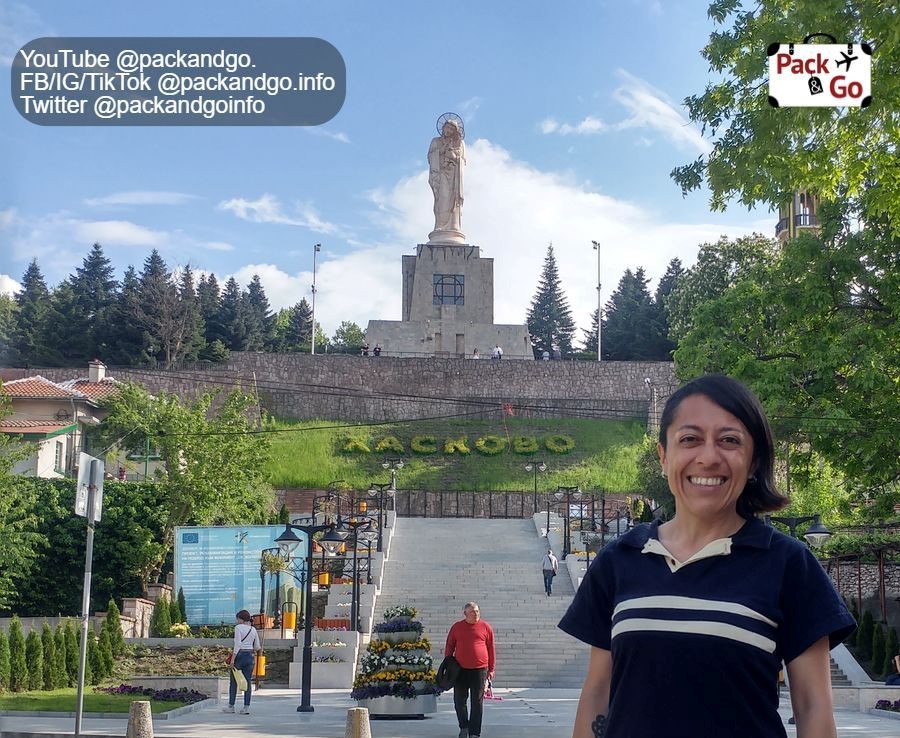
What to do in Haskovo?
There are many things to see in Haskovo. You can easily spend a weekend or even a full week in Haskovo and its surroundings, without getting bored.
Haskovo’s top attractions:
-
The monument of the Virgin Mary
-
Haskovo’s Bell Tower
-
San Stefano Street in Haskovo
-
The Monument of Envy
-
The Regional Historical Museum of Haskovo
-
Old Haskovo Clock Tower
-
1000 years Haskovo monument
-
Kenana Park
See the monument of the Virgin Mary (Monument of the Holy Mother of God)
Haskovo’s statue of the Virgin Mary is so monumental that it holds the Guinness world record for the highest monument of the Virgin Mary in the world. It is 32.8 meters high! What is so great about it is that it is located on a hill, so when you climb on it, you can see the whole Haskovo city.
Inside the statue, there is a small chapel called “Nativity of the Blessed Virgin Mary”. Greek tourists like to put candles inside the chapel.
The Virgin Mary statue is located inside Yamacha Park. There you can spend the whole afternoon, having a nice picnic or just a walk. And just next to the monument of the Virgin Mary, there is the Bell Tower of Haskovo.


Climb Haskovo’s Bell Tower
Inside Yamacha Park, just next to the Monument of the Holy Mother of God, you will find a beautiful Bell Tower. From the moment we saw it, we wanted to climb it. Of all the things to do in Haskovo, this one is a must. It has the best possible view of Haskovo. But there is a catch. Haskovo Bell Tower is a working clock tower. It rings the bells every hour, and there is nothing to stop you from climbing to the bells. Only a small sign in Bulgarian saying not to climb when it will ring. We arrived 10 minutes before the next ring. This pushed us to climb the tower in a hurry. We managed to do it and have a few photos from the top. Then it was a dash to the ground. Just as we sat on one bench below the Bell Tower started ringing. It has a powerful sound. I was glad we managed to get down on time or we could easily get deaf from the loud sound. Seriously, don’t stay up when it is ringing. It could be very harmful for your ears.
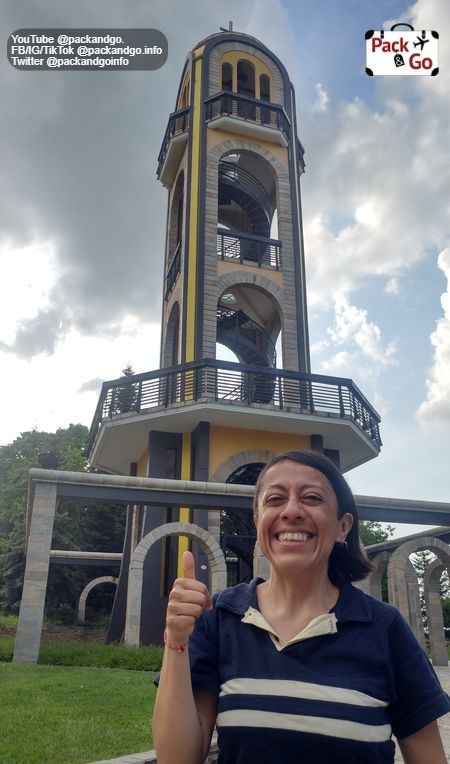
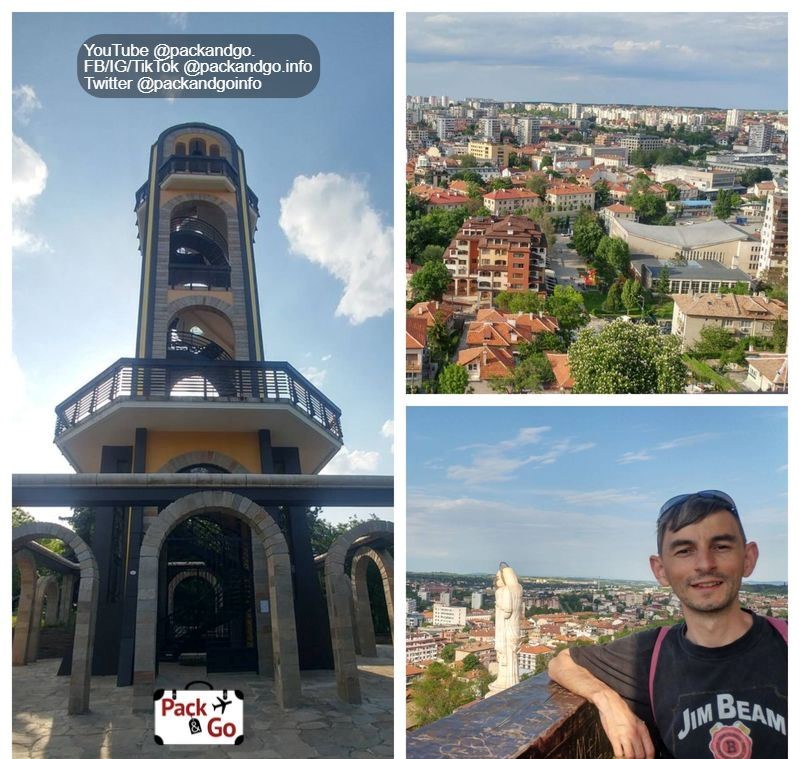
Walk on San Stefano Street towards the downtown of Haskovo
Start from the monument of Kapitan Petko Voyvoda and walk toward Obshtinski Square.
There you can find plenty of coffee places, restaurants, and fast food stands. We enjoyed a lot how lively this part of Haskovo was. You see people of all ages enjoying their time. If you are into Greek gyros or Turkish doner kebab, there are many options on the street.
The walk to the center of Haskovo is short, maybe around 10 minutes, but it is really pleasant. In the end, you will see the start of Obshtinski Square and the Monument of Envy.

Rest next to the Monument of Envy in Haskovo
The people from Haskovo are really proud of this monument. They say it is the only monument of Envy in the whole world. We can’t guarantee that, but it is not common when somebody creates a monument of a negative feature.
The monument of Envy in Haskovo represents a successful man, that has spread his wings and he is ready to fly high. But there is an ugly, skeleton hand, that drags him down, in an attempt of stopping him. With his sculpture, the author Gospodin Tenev (Guspata), wanted to say that there will always be envious people trying to stop you. And actually, you should embrace it. When the “ugly” people start to bother you, you should know you are on the right path to greatness.
Why should you see it? Because it is truly inspirational. Don’t give up when envious people come into your life. Fly away and resist the negativeness.
We got an ice cream from Billa and had a nice break next to the statue. On a hot day, ice cream and the drops from the fountain were a great combination.

Visit the Regional Historical Museum of Haskovo
If you are into museums visit the Regional Historical Museum of Haskovo. Why? Bulgaria has a rich history dating back to the stone age. What is interesting about Haskovo’s history is that it is located in the geographical area of Thrace. You can find some truly ancient artefacts from the Neolithic age (between 8000 to 5000 years BC!). You can explore history through all the tools that are still well-preserved. Going from stones to primitive metal tools and finishing in the middle ages.
Greek, Turkish, and Bulgarian tourists can enjoy the Regional Historical Museum in Haskovo, and see how these countries and their cultures have been intertwined together for many ages.
The entrance costs 2 BGN (around 1 euro) for adults and half price, 1 BGN for children and pensioners. It is worth it.
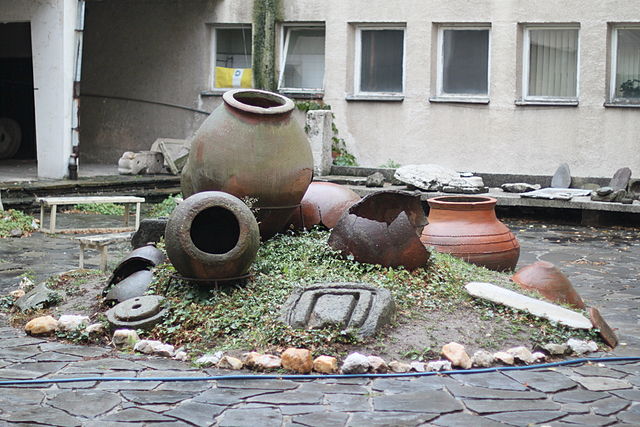
Check out the Old Haskovo Clock Tower
In Haskovo, you don’t need a watch, you can see the time everywhere. The Old Clock Tower of Haskovo was built at the beginning of the 19th century and still shows the time, in the center of the city. It is a 23-meter high Clock Tower, with a recently updated mechanism and the bell, created by the same company that built the Big Ben bell in London.

Eat Bulgarian food
We can’t just walk all day without getting hungry! Enjoy some traditional Bulgarian food in Haskovo. Here, you can enjoy a great fusion between Bulgarian, Turkish, and Greek cousins. You will find Pide, Musaka, different kebabs, Lahmacun, Kiopoolu, Banitza, filled paprikas with minced meat and rice, sarma, and more. Just writing these incredible foods makes me hungry.
Of course, there are pizzas and burgers, just like anywhere in the world, but Haskovo has great local food too. Try it out! Broaden your culinary culture!
| Follow PackAndGo.info at: | |
| YouTube | @packandgo. |
| @packandgo.info | |
| X | @packandgoinfo |
| @packandgo.info | |
| Bluesky | @packandgo.bsky.social |
| TikTok | @packandgo.info |
Check out the 1000 years Haskovo monument
While you are in the center of Haskovo, take pictures of the 1000 years of Haskovo monument. Here in this city, people love clock towers, so you can enjoy one more. It is a high building, 26.5 meters and it has a very cool design. It looks heavy, industrial and somehow reminds me of the Transformers.
The idea of the monument was to show the 4 directions of the world and to represent that Haskovo is on the way between the East (Asia), and West (Europe).
Sadly, tourists can’t climb on it.

Park Kenana (Lesnopark Kenana) and Haskovo Zoo (Kenana Park Zoo)
Do you fill like going into the forest? Lesopark Kenana gives you a great opportunity to do it. It is big and perfect for a walk with your family or pet. Kenana Park is both pet-friendly and kid-friendly. It is your escape from the city. It is located in the north part of Haskovo. You can easily arrive by car or public transport.
We saw many people that come to do their exercises here. Runners, cyclists, tennis players, yoga people and more.
In this forest environment, there is a small zoo too, the Kenana Park Zoo. With animals, typical for the Balkan forest like deer, rabbits, ducks, wolves, and more. The big exception is the lions. They look a bit out of place here, but the locals love them.
Bear in mind that there are no businesses inside the park. You need to prepare yourself with food and drinks.
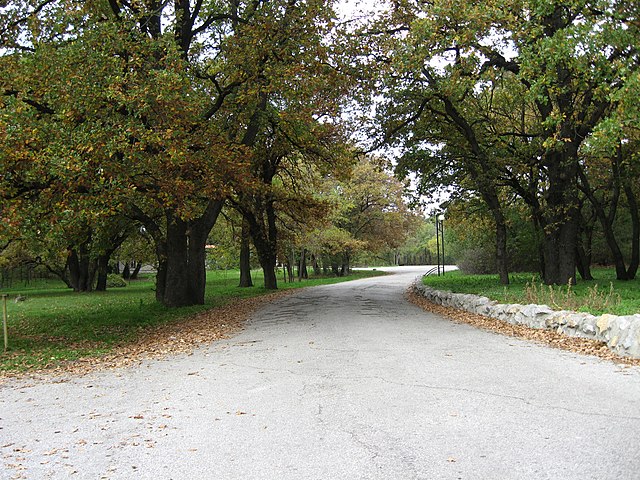
What to visit near Haskovo?
There are a few truly interesting places you can visit near Haskovo. Some will help you discover more about the history of the region, and others, will just feel your heart with joy from the nature’s beauty.
Top attractions in Haskovo’s surroundings:
- Historical museum Dimitrovgrad
- Thracian tomb of Aleksandrovo
- The Stone Mushrooms
- Perperikon (Perperek)
Historical museum Dimitorvgrad - 14 km away
You should visit it because you can learn more about the socialist past of Bulgaria. “Brigadier Movement in Bulgaria" hall focuses exactly on this period. You will see old uniforms, flags, different signs, photos, and awards from the Brigadiers' past.
The entrance is just 2 BGN for adults and half price (1 BGN) for children and pensioners.
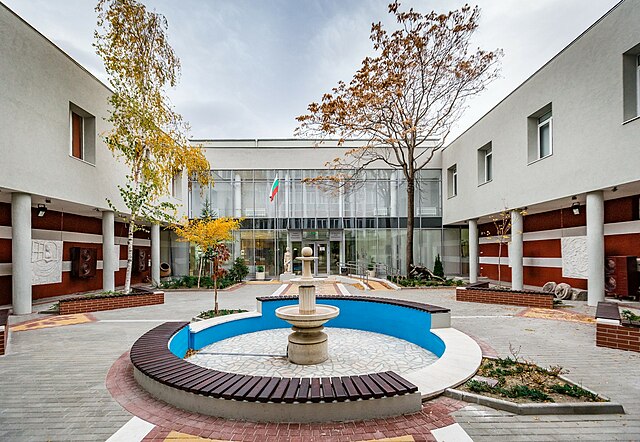
Alexandrovo Tomb (Thracian tomb of Aleksandrovo) – 16 km away
The Alexandrovo Tomb is an ancient Thracian tomb from the 4th century BC. The name of the ruler, resting in it remains a mystery. This is why some people speculate that it is the grave of Alexander the Great. He also died during the 4th century BC, and Macedonia is close. There are some chances this myth is true.
Even if the Tomb in Alexandrovo is not Alexander the Great’s tomb, you can still see some really unique artefacts like the Thracian frescos and amazing tomb architecture. A funny fact is that in one of the frescos, one participant in a hunt wears Greek sandals. This obviously shows how strong the Greek influence was in this region.
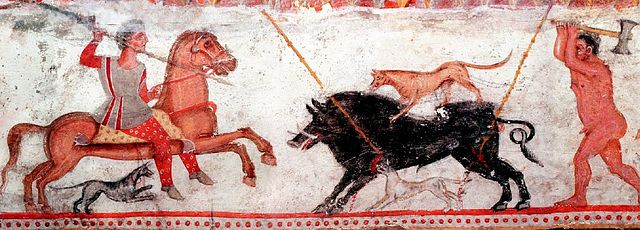
The Stone Mushrooms (Mushroom rocks) – 20 km away
The Stone Mushrooms is a unique rock phenomenon near the village of Beli Plast, between Haskovo and Kardzali. On our way to Kardzali, we stopped to check it out. The stones have a very extravagant form, that strongly resembles mushrooms. This is why they are called the Stone Mushrooms.
They are created from volcanic tuffs (learn about volcanos) rocks and have cool colors like pink (mineral cloinoptilolite), blue and black spots from manganese, and even green colors from the mineral celadonite.
Each stone mushroom is around 2.5 to 3 meters high, and there are more than several rocks around.
If you are into cool rock formations, you can also check Belogradchik, or Sliven, and its blue rocks.
There is no entrance fee for the Stone Mushrooms near Haskovo. They are free to visit.

Perperikon (Perperek) – 25 km away
Peperikon is another must-see landmark in Bulgaria. It is a Thracian holy place from 6 000 years BC! An ancient place! Currently, there are remains from the last middle age settlement there and a beautiful stone tower.
Thousands of tourists come to Perperikon, not only from Turkiye and Greece but also from all over the world.
Honestly, you can reach it from Haskovo easily, but it is just a bit closer to Kardzali. So if you want to know more about it, check out our Kadzali article (LINK).
Outro
So, what are you waiting for? You saw the pictures from Haskovo already.
If you are in Edirne, it is closer to come here than to go to Istanbul. It will be a whole new country with a different language and culture.
For Greeks, there are also many things to see in Haskovo. Greece is old, but Thrace has a lot of history too.
There are plenty of things to do in Haskovo. Just visit Haskovo already!
How to get to Haskovo?
From Turkey to Haskovo:
The distance between Edirne and Haskovo is just 100 km and it takes only hour and a half to get there. Check the navigation here.
The distance between Tekirdag and Haskovo is 250 km and it takes 3 hours to get there. Check the navigation here.
The distance between Istanbul and Haskovo is 345 km and it takes 4 hours to get there. Check the navigation here.
Turkish citizens must obtain a Bulgarian visa, before their trip. The process is not hard and it gives you the right to stay up to 90 days in Bulgaria. You can get a visa at the Bulgarian consulates or embassies in the following cities: Ankara, Bursa, Edirne, and Istanbul.
Check out how to get a Bulgarian visa here (LINK).
From Greece to Haskovo:
The distance between Komotini and Haskovo is just 118 km and it only takes 1 hour and 52 minutes to get there. Check the navigation here.
The distance between Alexandroupoli and Haskovo is 172 km and it takes 2 hours and a half to get there. Check the navigation here.
The distance between Kavala and Haskovo is 215 km and it takes 2 hours and 50 minutes to get there. Check the navigation here.
Greek people only need their ID cards or passports to cross.
For tourists within Bulgaria:
And of course, you can get easily get to Haskovo from different Bulgarian cities:
The distance between Kardzali and Haskovo is just 47 km and it takes only 45 minutes to get there. Check the navigation here
The distance between Stara Zagora and Haskovo is just 60 km and it takes only ah hour to get there. Check the navigation here
The distance between Plovdiv and Haskovo is 96.4 km and it takes 1 hour and 10 minutes to get there. Check the navigation here
The distance between Sliven and Haskovo is 136 km and it takes 1 hour and 40 minutes to get there. Check the navigation here!
| Follow PackAndGo.info at: | |
| YouTube | @packandgo. |
| @packandgo.info | |
| X | @packandgoinfo |
| @packandgo.info | |
| Bluesky | @packandgo.bsky.social |
| TikTok | @packandgo.info |
Page 2 of 6
